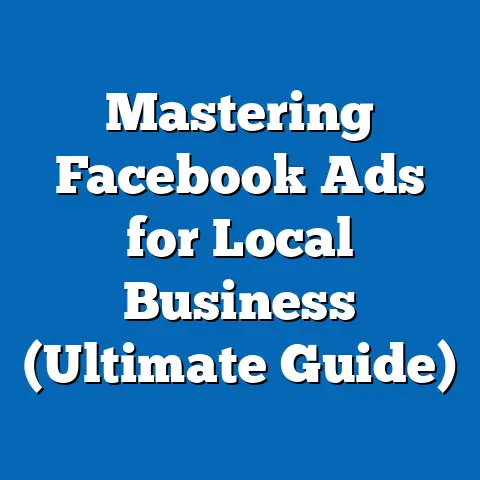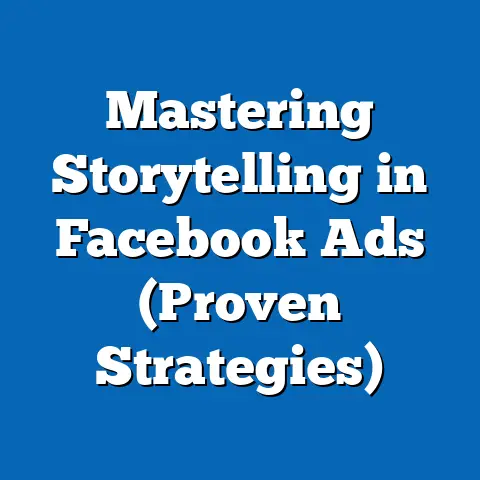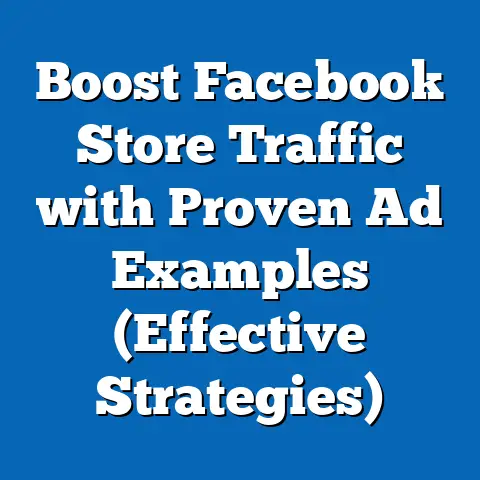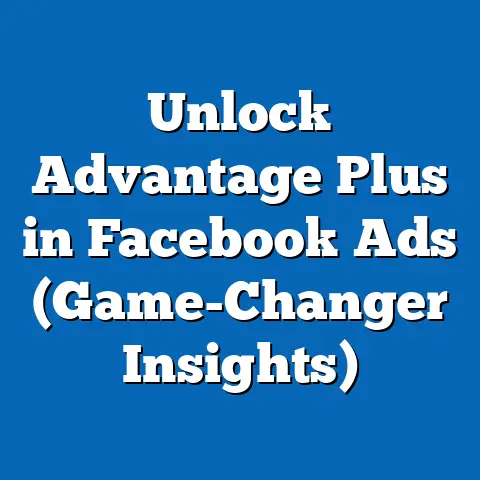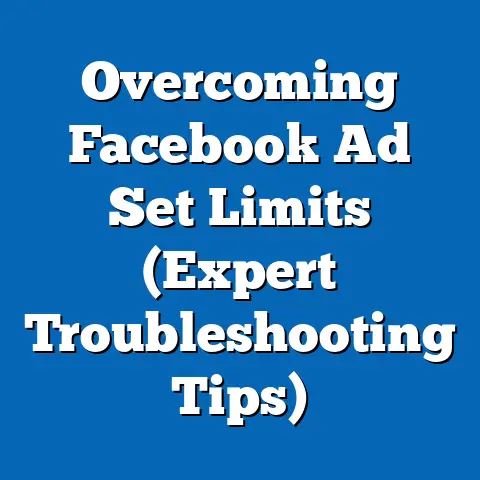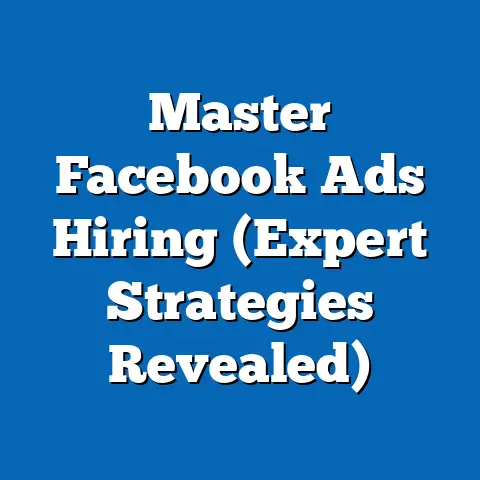Boost Amazon Associates with Facebook Ads (Proven Strategies)
It’s a common refrain I hear in affiliate marketing circles: “Facebook Ads? Nah, they don’t work for Amazon Associates.” This sentiment often arises from a place of frustration, perhaps after a few unsuccessful attempts to drive traffic directly to Amazon product pages. But I’m here to tell you that this belief is a misconception, born from a lack of understanding of how to leverage Facebook’s incredibly powerful advertising ecosystem.
Facebook Ads, when used strategically, can be an absolute game-changer for Amazon Associates. It’s not about blindly throwing money at ads and hoping for the best; it’s about understanding your audience, crafting compelling offers, and optimizing your campaigns based on data. In this guide, I’m going to walk you through proven strategies that I’ve personally used and seen others use to successfully boost their Amazon Associates earnings with Facebook Ads. These are not just abstract theories; they’re actionable methods backed by real-world case studies and years of experience in the trenches of digital marketing. So, buckle up, and let’s dive into how you can transform your Amazon Associates business with the power of Facebook Ads.
Understanding the Amazon Associates Program
The Amazon Associates program is essentially Amazon’s affiliate marketing program. It allows individuals and businesses to earn commission by promoting products sold on Amazon. You, as an associate, choose products to promote, create unique affiliate links, and share those links with your audience. When someone clicks your link and makes a purchase on Amazon, you earn a percentage of the sale.
The commission structure varies depending on the product category, ranging from 1% to 10% in some cases. While the commission rates might not seem huge at first glance, the sheer volume of products available on Amazon and the potential for driving significant traffic can lead to substantial earnings.
However, being an Amazon Associate isn’t always a walk in the park. Here are some typical challenges that many associates face:
- Competition: The affiliate marketing landscape is crowded, and many associates are promoting the same products.
- Low Conversion Rates: Simply driving traffic to a product page doesn’t guarantee sales. You need to ensure the traffic is targeted and the product page is compelling.
- The Importance of Targeted Traffic: Sending irrelevant traffic to Amazon can actually hurt your conversion rates and potentially even jeopardize your Associates account.
- Precise Targeting: Facebook allows you to target incredibly specific audiences based on demographics, interests, behaviors, and more. This means you can reach potential customers who are genuinely interested in the products you’re promoting.
- Enhanced Visibility: In a sea of online content, Facebook Ads help you stand out and get your products in front of the right people.
- Scalability: Once you find a winning ad campaign, you can easily scale it to reach a larger audience and increase your earnings.
Key Takeaway: The Amazon Associates program offers a fantastic opportunity to earn commission by promoting products on Amazon. However, success requires overcoming challenges like competition and low conversion rates. Facebook Ads offer a powerful solution by enabling precise targeting, enhanced visibility, and scalability.
Setting Up Your Facebook Ads for Success
Creating effective Facebook Ads tailored for promoting Amazon products involves a strategic approach. It’s not enough to simply throw up an ad with a product link and hope for the best. You need to carefully consider your audience, ad copy, visuals, and overall campaign structure. Let’s break down the essential steps:
Audience Targeting: Finding Your Ideal Customer
Facebook’s targeting options are incredibly granular, allowing you to pinpoint your ideal customer with remarkable accuracy. Here are some key targeting options to consider:
- Interest-Based Targeting: This is the most common form of targeting, where you target users based on their interests, hobbies, and pages they’ve liked. For example, if you’re promoting a gardening tool, you could target users interested in “gardening,” “organic gardening,” or “home gardening.”
- Lookalike Audiences: This is where things get really powerful. Lookalike audiences allow you to create audiences that are similar to your existing customers or website visitors. For example, you can upload a list of your existing Amazon customers to Facebook and create a lookalike audience based on their characteristics.
- Custom Audiences: Custom audiences allow you to target users who have already interacted with your business in some way. This could include website visitors, email subscribers, or people who have engaged with your previous Facebook posts.
- Demographic Targeting: Don’t forget the basics! You can also target users based on age, gender, location, education, and other demographic factors.
Example: Let’s say you’re promoting a high-end coffee maker on Amazon. Here’s how you might approach audience targeting:
- Interests: “Coffee,” “Espresso,” “Home Barista,” “Gourmet Coffee”
- Demographics: Age 25-55, Income $75,000+, Located in urban areas
- Behaviors: People who have purchased coffee makers online in the past
By combining these targeting options, you can create a highly targeted audience that is more likely to be interested in your product.
Crafting Compelling Ad Copy and Visuals
Your ad copy and visuals are the first things potential customers will see, so it’s crucial to make a strong impression. Here are some tips for creating compelling ads:
- Write Engaging Headlines: Your headline should be attention-grabbing and clearly communicate the value of the product. Use strong verbs and create a sense of curiosity.
- Highlight Benefits, Not Just Features: Focus on how the product will improve the customer’s life, rather than simply listing its features. For example, instead of saying “This coffee maker has a 15-bar pump,” say “Enjoy barista-quality espresso in the comfort of your own home.”
- Use High-Quality Images and Videos: Visuals are essential for capturing attention. Use high-resolution images and videos that showcase the product in its best light. Consider using lifestyle images that show the product in use.
- Include a Clear Call-to-Action: Tell users what you want them to do. Use clear and concise call-to-action buttons like “Shop Now,” “Learn More,” or “See on Amazon.”
Example: Here’s an example of compelling ad copy for the coffee maker:
Crafting Irresistible Offers
Simply showing a product isn’t always enough to entice users to click through to Amazon and make a purchase. You need to create an offer that is truly irresistible. This involves leveraging seasonal promotions, discounts, and exclusive deals to spark curiosity and urgency.
Leveraging Seasonal Promotions and Discounts
Take advantage of holidays and seasonal events to create time-sensitive offers. For example, during Black Friday, you could promote products with special discounts or bundles. During the summer, you could promote outdoor products with a “Summer Sale” offer.
Example: Let’s say you’re promoting a portable Bluetooth speaker. During the summer, you could create an ad with the following offer:
Example: Let’s say you’re promoting a set of kitchen knives. You could create an ad with the following offer:
- Scarcity: Create a sense of urgency by limiting the availability of the offer. For example, you could say “Only 100 units available!” or “Offer ends soon!”
- Social Proof: Show that other people have purchased and enjoyed the product. Use testimonials, reviews, or ratings to build trust.
- Reciprocity: Offer something of value for free, such as a free ebook or a discount code. This can create a sense of obligation in the customer and make them more likely to purchase.
- Loss Aversion: People are more motivated to avoid losses than they are to gain something. Highlight what the customer will miss out on if they don’t take advantage of the offer.
Key Takeaway: Crafting irresistible offers is essential for driving clicks and conversions. By leveraging seasonal promotions, discounts, bundling, and psychological principles, you can create offers that entice users to click through to Amazon and make a purchase.
Utilizing Retargeting Strategies
Not everyone who clicks on your ad will make a purchase right away. In fact, most people need to see your ad multiple times before they’re ready to buy. This is where retargeting comes in.
The Power of Retargeting
Retargeting is the process of showing ads to people who have already interacted with your business in some way, such as visiting your website or engaging with your previous ads. It’s a powerful way to nurture leads who have shown interest but didn’t convert initially.
Think of it this way: someone clicks on your ad for that high-end coffee maker, browses the product page, but then gets distracted and leaves Amazon. Retargeting allows you to show them another ad reminding them of the coffee maker and encouraging them to complete their purchase.
Setting Up Retargeting Campaigns on Facebook
Setting up retargeting campaigns on Facebook involves creating custom audiences based on website visitors or engagement with previous ads. Here’s how to do it:
- Install the Facebook Pixel on Your Website: The Facebook Pixel is a small piece of code that you place on your website to track visitor behavior. This allows you to create custom audiences based on the pages people have visited.
- Create a Custom Audience: In Facebook Ads Manager, create a custom audience based on website visitors who have visited specific product pages on Amazon. You can also create custom audiences based on people who have engaged with your previous Facebook posts.
- Create a Retargeting Ad Campaign: Create a new ad campaign and target your custom audience.
- Craft Compelling Retargeting Ads: Your retargeting ads should remind users of the products they viewed and encourage them to return to Amazon to complete their purchase.
Crafting Effective Retargeting Ads
Your retargeting ads should be different from your initial ads. They should focus on reminding users of the products they viewed and encouraging them to complete their purchase. Here are some tips:
- Use a Different Headline and Description: Don’t use the same ad copy as your initial ad. Try a different angle or highlight a different benefit.
- Offer a Discount or Free Shipping: Incentivize users to complete their purchase by offering a discount or free shipping.
- Use a Sense of Urgency: Create a sense of urgency by saying “Limited time offer!” or “Only a few units left!”
- Show the Product They Viewed: Remind users of the specific product they viewed by showing it in the ad.
Example: Here’s an example of a retargeting ad for the coffee maker:
Analyzing and Optimizing Your Campaigns
Running Facebook Ads is not a “set it and forget it” activity. You need to constantly analyze your campaign performance and make adjustments to optimize your results. This involves tracking key metrics, using Facebook Ads Manager to analyze data, and A/B testing different ad elements.
Tracking Key Metrics
Tracking the right metrics is essential for assessing the performance of your Facebook Ads. Here are some key performance indicators (KPIs) to monitor:
- Click-Through Rate (CTR): This is the percentage of people who see your ad and click on it. A high CTR indicates that your ad is relevant and engaging to your target audience.
- Conversion Rate: This is the percentage of people who click on your ad and make a purchase on Amazon. A high conversion rate indicates that your product page is compelling and your offer is attractive.
- Cost Per Click (CPC): This is the amount you pay each time someone clicks on your ad. A low CPC indicates that your ad is efficient and you’re not overpaying for clicks.
- Return on Ad Spend (ROAS): This is the amount of revenue you generate for every dollar you spend on advertising. A high ROAS indicates that your campaign is profitable.
Using Facebook Ads Manager to Analyze Data
Facebook Ads Manager provides a wealth of data that you can use to analyze your campaign performance. Here are some key features to use:
- Reporting: Use the reporting feature to track your KPIs over time. You can also segment your data by demographics, interests, and other factors to identify what’s working and what’s not.
- Attribution: Use the attribution feature to understand how your ads are contributing to sales. This can help you determine which ads are most effective at driving conversions.
- A/B Testing: Use the A/B testing feature to test different ad elements, such as headlines, images, and call-to-action buttons. This can help you optimize your ads for maximum performance.
A/B Testing for Continuous Optimization
A/B testing, also known as split testing, is the process of comparing two versions of an ad to see which one performs better. This is a crucial step in optimizing your campaigns for maximum performance.
Here are some ad elements you can A/B test:
- Headlines: Test different headlines to see which one is most attention-grabbing.
- Images: Test different images to see which one is most visually appealing.
- Call-to-Action Buttons: Test different call-to-action buttons to see which one is most likely to drive clicks.
- Targeting Options: Test different targeting options to see which audience is most responsive.
Key Takeaway: Analyzing and optimizing your campaigns is an ongoing process. By tracking key metrics, using Facebook Ads Manager to analyze data, and A/B testing different ad elements, you can continuously improve your campaign performance and maximize your ROAS.
Conclusion
Facebook Ads can be an incredibly powerful tool for boosting the success of Amazon Associates. By following the proven strategies outlined in this guide, you can overcome the challenges of competition and low conversion rates and drive targeted traffic to your Amazon product pages.
Remember, it’s not about blindly throwing money at ads and hoping for the best. It’s about understanding your audience, crafting compelling offers, utilizing retargeting strategies, and constantly analyzing and optimizing your campaigns.
I encourage you to experiment with these techniques and share your results. The affiliate marketing community thrives on collaboration and shared knowledge. By sharing your experiences, you can help others succeed and learn from their successes as well.
Now it’s time to take action. Integrate Facebook advertising into your Amazon Associates strategy and start seeing the results for yourself. Start small, test different approaches, and continuously optimize your campaigns. With the right strategy and execution, you can unlock the full potential of Facebook Ads and significantly boost your Amazon Associates earnings. So, what are you waiting for? Go out there and start creating some winning campaigns!

